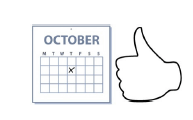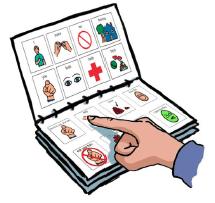Provision of communication equipment and support: easy read guidance
Easy read version of the Provision of Communication Equipment and Support guidance.
Guide on the Definitions of Communication Equipment and Support
Easy Read version

Introduction

Communication is a very important part of our daily lives. Some people who have lost their voice or have difficulty speaking may need to communicate using special equipment and support. This can be known as Augmentative and Alternative Communication (AAC).

The Scottish Government wants to make life better for children and adults across Scotland who need communication equipment and support.

To make this happen, we have changed the law so that all children and adults in Scotland have the right to the communication equipment and support they need.

Different organisations will be involved in giving people help to get the communication equipment and support they need, including Health Boards and Education Authorities. This guide gives these organisations the information they need to make this happen.

Experts have worked with us to make this guide. We would like to thank everyone involved for their time, advice and support.
Part 1: Our Vision

People who have difficulty speaking or who have lost the ability to speak have the right to communication equipment and support when they need it.

This is true for everyone, no matter who they are or where they live in Scotland.

This will help them to play an active part in their communities and be fully included in society.
Part 2: Principles

The Scottish Government promises to respect and protect the human rights of everyone in Scotland and make equality, dignity and respect a part of everything it does.

Communication and being free to express yourself is a basic human right. People with communication difficulties might need Augmentative and Alternative Communication (AAC) so they can fully express themselves in their daily life.
There are 5 principles
1. Dignity and Respect

I have the right to communicate how and when I want.
My communication needs are as important as my physical needs, and my mental health and wellbeing.
People know how to communicate with me.

2. Compassion
I get support to use my communication equipment from people who understand me and support my needs and wishes.

3. Included
I am involved in deciding what my communication needs are and what communication equipment and support I should have.

I get information about my communication equipment and support in a way that I can understand.

I can give feedback on my experience with my communication equipment and support so that I can get the best service possible.

My communication support enables me to take part in society and means I can do what is important to me.
4. Care and Support that meets my needs

I have the right to equal access to communication equipment and support that meets my needs.

The people giving me my communication equipment and support should have the right knowledge, skills and experience, or have access to this.

If my local service cannot give me the communication equipment and support that meets my needs, another team with the right knowledge, skills and experience will be contacted to provide the right advice and support.

I will know when my communication equipment will be given to me and by whom.

I will be given the right communication equipment and support as quickly as possible. This will be done in a way that suits my needs and takes my future needs into account.

My communication equipment and support will be given to me by organisations that work well together.

When my needs change my communication and support needs will be changed at the right time too, if they need to be.
5. Wellbeing

My communication equipment and support enable me to do what I want to do.

My communication equipment and support enable me to communicate with who I need or want to. This includes other people who use communication equipment.

I am given the help I need to enable me to communicate in my daily life and in the community.
I am supported and helped to develop new communication skills.
My communication equipment will be appropriate, easy to use, and safe.
Part 3: Communication Equipment and Support

Communication equipment is any equipment that enables a person to communicate in a way that supports or takes the place of speaking.

It might be used by people who can’t talk or who can’t talk clearly enough to meet their daily needs. The equipment is used to support a person to communicate in their daily life and help them do all the things they want to do.

The equipment used can change over a person’s lifetime but will always include a communication aid that gives a message in place of speech.

Communication equipment can be ‘low tech’ (no battery) or ‘high tech’ (battery powered ). Some people might use both.
Low tech communication equipment

Some example of low tech communication equipment:
- Pen and paper or a wipe board
- Flash cards
- Communication books with letters, words, pictures and/or symbols (these can be books with different pages of symbols for different topics)
- A communication board with the alphabet or pictures set out on a grid

It takes time to make low tech communication equipment that suits the needs of each person.
High tech communication equipment

This is electronic equipment that needs to be powered by a battery or charged up at a power socket.
It gives a way to communicate with people face-to-face or at a distance. It usually has a voice output that can be supported by text, pictures or symbols. It is usually portable.
High tech communication can be simple or complicated.
Support

Everyone involved in giving a person communication equipment and support should know what the person’s needs are, how they should be met, and how the equipment is used.
This might involve working with the person’s friends, carers and people who work with them, to make sure the person is able to use the communication equipment to meet their needs.
Support given should meet each person’s own needs and aim to help them do what they want to do.
For more information please go to: https://www.gov.scot/Resource/0053/00535995.pdf
Contact
Email: Heather Palmer
There is a problem
Thanks for your feedback